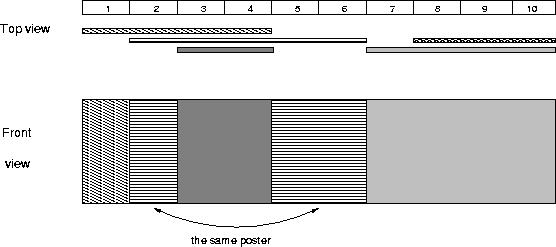Mayor's posters
| Time Limit: 1000MS | Memory Limit: 65536K | |
| Total Submissions: 65311 | Accepted: 18875 |
Description
The citizens of Bytetown, AB, could not stand that the candidates in the mayoral election campaign have been placing their electoral posters at all places at their whim. The city council has finally decided to build an electoral wall for placing the posters and introduce the following rules:
They have built a wall 10000000 bytes long (such that there is enough place for all candidates). When the electoral campaign was restarted, the candidates were placing their posters on the wall and their posters differed widely in width. Moreover, the candidates started placing their posters on wall segments already occupied by other posters. Everyone in Bytetown was curious whose posters will be visible (entirely or in part) on the last day before elections.
Your task is to find the number of visible posters when all the posters are placed given the information about posters' size, their place and order of placement on the electoral wall.
- Every candidate can place exactly one poster on the wall.
- All posters are of the same height equal to the height of the wall; the width of a poster can be any integer number of bytes (byte is the unit of length in Bytetown).
- The wall is divided into segments and the width of each segment is one byte.
- Each poster must completely cover a contiguous number of wall segments.
They have built a wall 10000000 bytes long (such that there is enough place for all candidates). When the electoral campaign was restarted, the candidates were placing their posters on the wall and their posters differed widely in width. Moreover, the candidates started placing their posters on wall segments already occupied by other posters. Everyone in Bytetown was curious whose posters will be visible (entirely or in part) on the last day before elections.
Your task is to find the number of visible posters when all the posters are placed given the information about posters' size, their place and order of placement on the electoral wall.
Input
The first line of input contains a number c giving the number of cases that follow. The first line of data for a single case contains number 1 <= n <= 10000. The subsequent n lines describe the posters in the order in which they were placed. The i-th line among the n lines contains two integer numbers l
i and ri which are the number of the wall segment occupied by the left end and the right end of the i-th poster, respectively. We know that for each 1 <= i <= n, 1 <= l
i<= ri <= 10000000. After the i-th poster is placed, it entirely covers all wall segments numbered l
i, l
i+1 ,... , ri.
Output
For each input data set print the number of visible posters after all the posters are placed.
The picture below illustrates the case of the sample input.

The picture below illustrates the case of the sample input.

Sample Input
1 5 1 4 2 6 8 10 3 4 7 10
Sample Output
4
题目大意:给你一个区域,你可以在这个区域里贴一些海报,后面贴的海报可以把前面贴的海报覆盖掉,问贴完之后,能在表面看到几种海报。
解题思路:这题数据范围很大,直接搞超时+超内存,需要离散化。
离散化:
离散化,把无限空间中有限的个体映射到有限的空间中去,以此提高算法的时空效率。
通俗的说,离散化是在不改变数据相对大小的条件下,对数据进行相应的缩小。例如:
原数据:1,999,100000,15;处理后:1,3,4,2;
原数据:{100,200},{20,50000},{1,400};
处理后:{3,4},{2,6},{1,5};
离散化是程序设计中一个非常常用的技巧,它可以有效的降低时间复杂度。其基本思想就是在众多可能的情况中“只考虑我需要用的值”。离散化可以改进一个低效的算法,甚至实现根本不可能实现的算法。要掌握这个思想,必须从大量的题目中理解此方法的特点。
举例:建造线段树空间不够,可以考虑离散化。
ac代码如下:
#include <iostream>
#include <cstring>
#include <cstdio>
#include <algorithm>
using namespace std;
#define M 10005
int m, li[M], ri[M];
int x[M<<3], col[M<<4], ans;
bool hash[M];
void PushDown(int rt) {
col[rt<<1] = col[rt<<1|1] = col[rt];
col[rt] = -1;
}
void Update(int L, int R, int c, int l, int r, int rt) {
if (l >= L && r <= R) {
col[rt] = c;
return;
}
if (col[rt] != -1) PushDown(rt);
int m = (l + r) >> 1;
if (m >= L) Update(L, R, c, l, m, rt<<1);
if (m < R) Update(L, R, c, m+1, r, rt<<1|1);
}
void query(int l, int r, int rt) {
if (l == r) {
if (!hash[col[rt]]) {
ans++;
hash[col[rt]] = true;
}
return;
}
if (col[rt] != -1) PushDown(rt);
int m = (l + r) >> 1;
query(l, m, rt<<1);
query(m+1, r, rt<<1|1);
}
int BSearch(int ll, int hh, int xx) {
int mm;
while (ll <= hh) {
mm = (ll + hh) >> 1;
if (x[mm] == xx) return mm;
else if (x[mm] > xx) hh = mm - 1;
else ll = mm + 1;
}
return -1;
}
int main()
{
int t, n, i;
scanf ("%d", &t);
while (t--) {
memset(col, -1, sizeof (col));
memset (hash, false, sizeof (hash));
int nn = 0;
scanf ("%d", &n);
for (i = 1; i <= n; i++) {
scanf ("%d %d", &li[i], &ri[i]);
x[++nn] = li[i];
x[++nn] = ri[i];
}
sort(x+1, x+nn+1);
m = 1;
for (i = 2; i <= nn; i++) {
if (x[i] != x[i-1]) x[++m] = x[i];
}
for (i = m; i > 1; i--) {
if (x[i] - x[i-1] > 1) x[++m] = x[i] - 1;
}
sort(x+1, x+m+1);
for (i = 1; i <= n; i++) {
int l = BSearch(1, m, li[i]);
int r = BSearch(1, m, ri[i]);
Update(l, r, i, 1, m, 1);
}
ans = 0;
query(1, m, 1);
printf("%d\n", ans);
}
return 0;
}


























 480
480

 被折叠的 条评论
为什么被折叠?
被折叠的 条评论
为什么被折叠?








